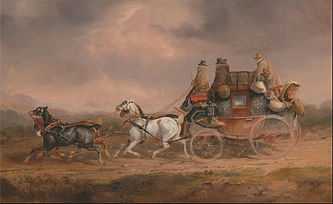Charles Cooper Henderson
| Charles Cooper Henderson | |
|---|---|
|
Work by Charles Cooper Henderson: Mail Coaches on the Road The Louth-London Royal Mail progressing at Speed by Henderson | |
| Born |
14 June 1803 Abbey House, Chertsey, Surrey, England |
| Died |
21 August 1877 (aged 74) Lower Halliford, England |
| Known for | Painting horses |
Charles Cooper Henderson (14 June 1803 – 21 August 1877) was a British painter of horses and coaches.
Life
Henderson was born in Abbey House, Chertsey, Surrey to John Henderson and Georgiana Jane (born Keate). His maternal grandfather was George Keate and his elder brother was John Henderson, the antiquary and benefactor of the British Museum. He was sent to Winchester School and then studied to be a lawyer. His father was an amateur artist and patron and his mother had exhibited four of her paintings in 1791.[1] Henderson trained under Samuel Prout.
Henderson was estranged from his father after he married a young girl called Charlotte By in 1828. They were to have nine children together and seven of these were boys.[2] Their children were Charles Cooper (the younger), John Keate Shepard, Charlotte (the younger), Kennart Gregg, Robert, Mary, Roderick William, George By and Henry Cooper Henderson. They all lived out of their infancy but Robert died whilst still a child. Henderson had just two paintings exhibited at the Royal Academy, both in the 1840s.[3]

In 1850, Henderson inherited his family's money when his mother died.[3] His mother's money had come from George Keate. In 1805 his mother and father were failing to maintain 250 dilapidated houses in Whitechapel, but they were still receiving £700 in income.[4] He also came into money from his wife's family who had land in Canada.[5] With no worries about his income, Henderson took the opportunity to give his energies to painting.[3] In 1877 Henderson died a widower at his home, 3 Lamb's Conduit Place, London, on 21 August 1877.
Legacy
The poorly maintained houses in Whitechapel that maintained the Henderson family were bringing in four pence per room per night where they were common lodging houses in the year that Henderson died. Eleven years later it was this area that became notorious in its association with Jack the Ripper.[4] Many of Henderson's paintings were engraved by a number of people including himself. Prints of his coaching scenes are valued and collected.[6] He has original paintings in several public collections in Dublin[7] and in the UK.[8] Henderson was buried in Kensal Green Cemetery and he has a memorial at St Nicholas's Church in Shepperton.[3]
References
- ↑ Haydn Mason, "Keate, George (1729–1797)", Oxford Dictionary of National Biography, Oxford University Press, 2004; online edn, Oct 2007 accessed 22 Oct 2013
- ↑ Charles Cooper Handerson, Stanford University, retrieved October 2013
- ↑ 3.0 3.1 3.2 3.3 L. H. Cust, 'Henderson, Charles Cooper (1803–1877)', rev. Romita Ray, Oxford Dictionary of National Biography, Oxford University Press, 2004; online edn, May 2005 accessed 22 Oct 2013
- ↑ 4.0 4.1 Begg, Paul (2013). Jack the Ripper: The Definitive History. p. 24 (footnotes on 31–32). ISBN 1317866339.
- ↑ Statutes of the Province of Canada. Canada. 1866. p. 708.
- ↑ Russell, Ronald (2001). Discovering Antique Prints. p. 52. ISBN 0747804990.
- ↑ Wright, compiled by Christopher et al. (2006). British and Irish paintings in public collections: an index of British and Irish oil paintings by artists born before 1870 in public and institutional collections in the United Kingdom and Ireland. New Haven, Conn.: Yale University Press. ISBN 0300117302.
- ↑ Paintings by Charles Cooper Henderson at the BBC Your Paintings site
External links
| Wikisource has the text of the 1885–1900 Dictionary of National Biography's article about Charles Cooper Henderson. |
![]() Media related to Charles Cooper Henderson at Wikimedia Commons
Media related to Charles Cooper Henderson at Wikimedia Commons
